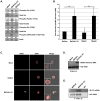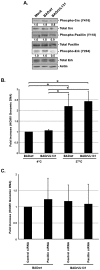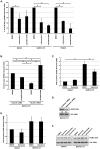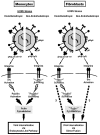The HCMV gH/gL/UL128-131 complex triggers the specific cellular activation required for efficient viral internalization into target monocytes
- PMID: 23853586
- PMCID: PMC3708883
- DOI: 10.1371/journal.ppat.1003463
The HCMV gH/gL/UL128-131 complex triggers the specific cellular activation required for efficient viral internalization into target monocytes
Abstract
We have established that HCMV acts as a specific ligand engaging and activating cellular integrins on monocytes. As a result, integrin signaling via Src activation leads to the functional activation of paxillin required for efficient viral entry and for the biological changes in monocytes needed for viral dissemination. These biological/molecular changes allow HCMV to use monocytes as "vehicles" for systemic spread and the establishment of lifelong persistence. However, it remains unresolved how HCMV specifically induces this observed monocyte activation. It was previously demonstrated that the HCMV gH/gL/UL128-131 glycoprotein complex facilitates viral entry into biologically relevant cell types. Nevertheless, the mechanism by which the gH/gL/UL128-131 complex promotes this process is unknown. We now show that only HCMV virions possessing the gH/gL/UL128-131 complex are capable of activating integrin/Src/paxillin-signaling in monocytes. In fibroblasts, this signaling is reversed, such that virus lacking the gH/gL/UL128-131 complex is the only virus able to induce the paxillin activation cascade. The presence of the gH/gL/UL128-131 complex also may have an inhibitory effect on integrin-mediated signaling pathway in fibroblasts. Furthermore, we demonstrate that the presence of the gH/gL/UL128-131 complex on the viral envelope, through its activation of the integrin/Src/paxillin pathway, is necessary for efficient HCMV internalization into monocytes and that appropriate actin and dynamin regulation is critical for this entry process. Importantly, productive infection in monocyte-derived macrophages was seen only in cells exposed to HCMV expressing the gH/gL/UL128-131 complex. From our data, the HCMV gH/gL/U128-131 complex emerges as the specific ligand driving the activation of the receptor-mediated signaling required for the regulation of the actin cytoskeleton and, consequently, for efficient and productive internalization of HCMV into monocytes. To our knowledge, our studies demonstrate a possible molecular mechanism for why the gH/gL/UL128-131 complex dictates HCMV tropism and why the complex is lost as clinical isolates are passaged in the laboratory.
Conflict of interest statement
The authors have declared that no competing interests exist.
Figures






References
-
- Speir E, Modali R, Huang ES, Leon MB, Shawl F, et al. (1994) Potential role of human cytomegalovirus and p53 interaction in coronary restenosis. Science 265: 391–394. - PubMed
-
- Melnick JL, Adam E, DeBakey ME (1995) Cytomegalovirus and atherosclerosis. Bioessays 17: 899–903. - PubMed
-
- Streblow DN, Vomaske J, Smith P, Melnychuk R, Hall L, et al. (2003) Human cytomegalovirus chemokine receptor US28-induced smooth muscle cell migration is mediated by focal adhesion kinase and Src. J Biol Chem 278: 50456–50465. - PubMed
-
- Waldman WJ, Adams PW, Knight DA, Sedmak DD (1997) CMV as an exacerbating agent in transplant vascular sclerosis: potential immune-mediated mechanisms modelled in vitro. Transplant Proc 29: 1545–1546. - PubMed
-
- Streblow DN, Orloff SL, Nelson JA (2001) Do pathogens accelerate atherosclerosis? J Nutr 131: 2798S–2804S. - PubMed
Publication types
MeSH terms
Substances
Grants and funding
LinkOut - more resources
Full Text Sources
Other Literature Sources
Research Materials
Miscellaneous

